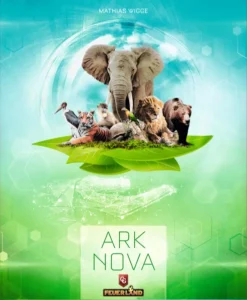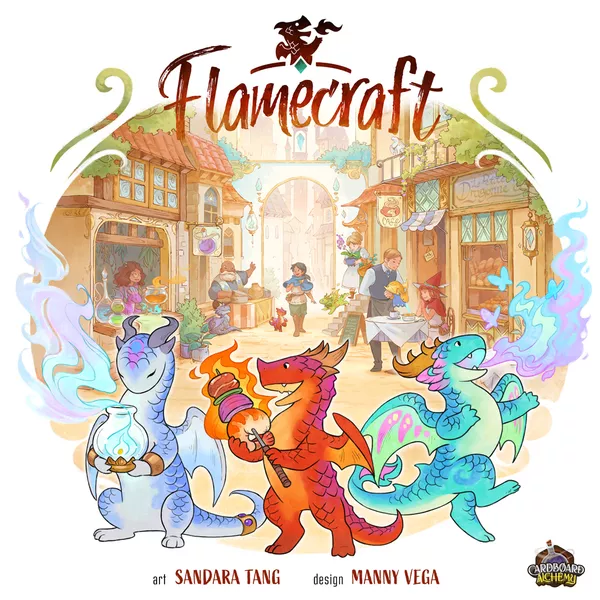
Today, we’re taking a look at “Flamecraft,” a whimsical board game designed by Manny Vega & published by Cardboard Alchemy. This game brings a magical twist with its charming artisan dragons. Let’s break it down – what it is, what’s good, what’s bad, & if you should pick it up. Let’s get into it.
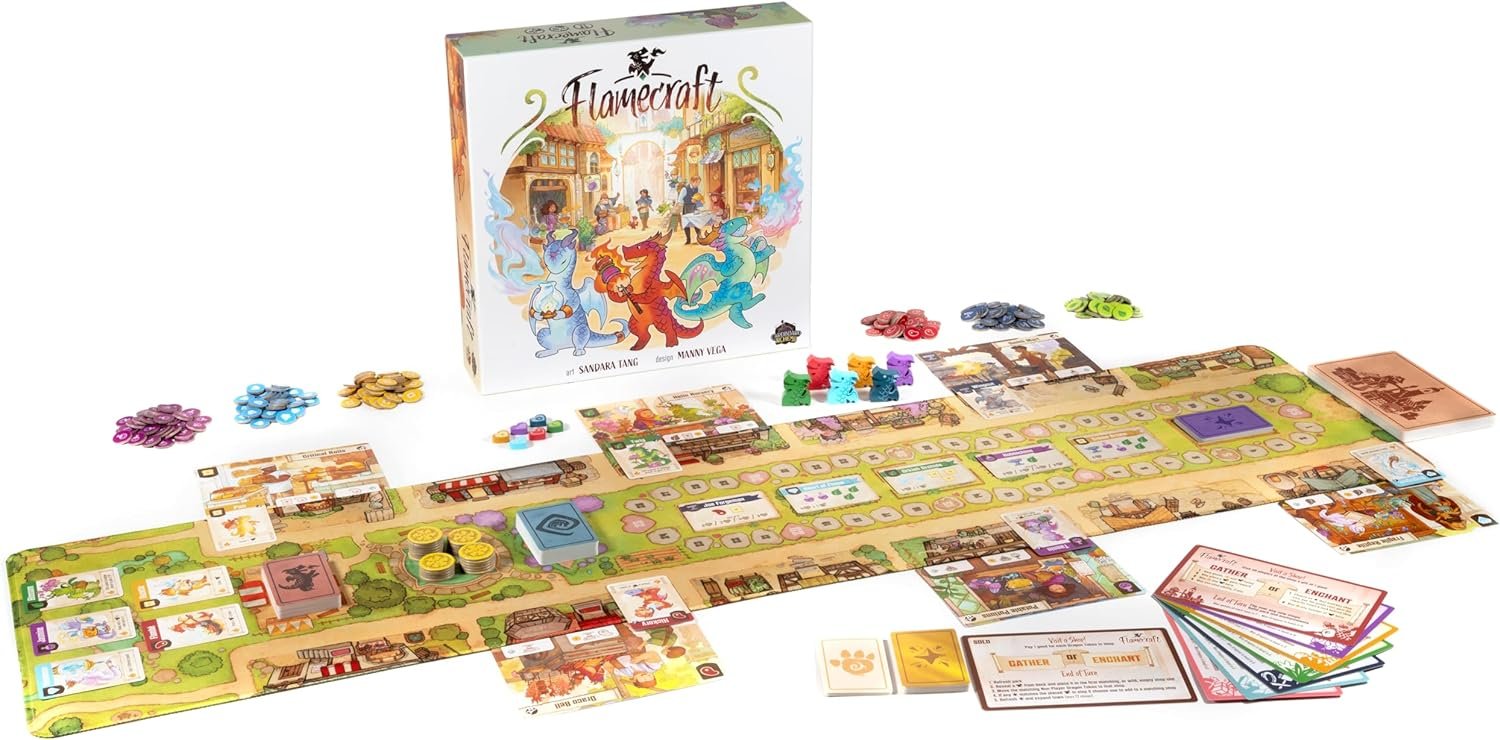
What It Is
“Flamecraft” is a family-friendly, light strategy game where 1-5 players assume the roles of Flamekeepers. These skilled individuals communicate with artisan dragons to place them in shops around the town, casting enchantments to produce marvelous goods. The objective is to gain the most reputation by the end of the game, becoming the Master of Flamecraft.
Gameplay Mechanics
Flamecraft begins with six starter shops placed near the town, each paired with a starter artisan dragon that provides a unique power & associated resource. A deck of 10 shop cards is shuffled & placed nearby, alongside decks for Artisan Dragons, Fancy Dragons, & Enchantments. Displays of 5 Enchantment cards & 5 Artisan dragons are set up, with goods & coins placed in a central supply, where coins also serve as victory points (VP) at the game’s end.
Each player selects a player token & aid in their chosen color, placing a score piece near the track. Players receive 3 Artisan Dragons & choose 1 of 2 Fancy Dragons, each offering different scoring mechanics during the game or final scoring. The starting player is determined, possibly receiving compensatory goods.
On each turn, players must visit one of the available shops in town, placing their dragon pawn on the corresponding shop card. They then have two main options:
- Gather Goods: Gather goods or coins from the shop & any Artisan Dragons present. As shops become more prosperous over time, future visits yield more resources. Players can also add an Artisan Dragon to a shop, matching the icon on the card to increase future rewards.
- Enchant: Cast an enchantment on a shop by selecting a suitable spell from the faceup row matching the shop’s icon. Enchantments require specific quantities of goods to fulfill their “recipe,” permanently enhancing the shop’s resource production. Enchanting also awards reputation (VP).
After taking their main action, players adjust the game state by flipping face-down shops, managing hand & supply limits, & refreshing displays of Artisan dragons & Enchantments.
The game progresses until either the Enchantment Deck or Artisan Dragon Deck is depleted, allowing each player one final turn. Final scoring includes VP from remaining coins, scoring criteria of Fancy Dragons, & bonuses for Artisan Dragons. Ties favor the player with the most Artisan Dragons.
The solo mode of Flamecraft simplifies upkeep while maintaining a competitive feel. Players manage a simulated opponent through automated actions: revealing & placing Artisan Dragons in shops, potentially blocking prime positions, & casting enchantments. While simplified compared to multiplayer, the solo mode offers unlockable achievements that modify gameplay, extending replayability by introducing new challenges & strategies.
However, the solo mode lacks full integration of all multiplayer aspects, such as companion cards & the complete Fancy Dragon deck, limiting strategic depth compared to multiplayer sessions. Despite these limitations, the solo experience benefits from its streamlined setup & the addition of unlockable achievements, enhancing its longevity as a solo board game.
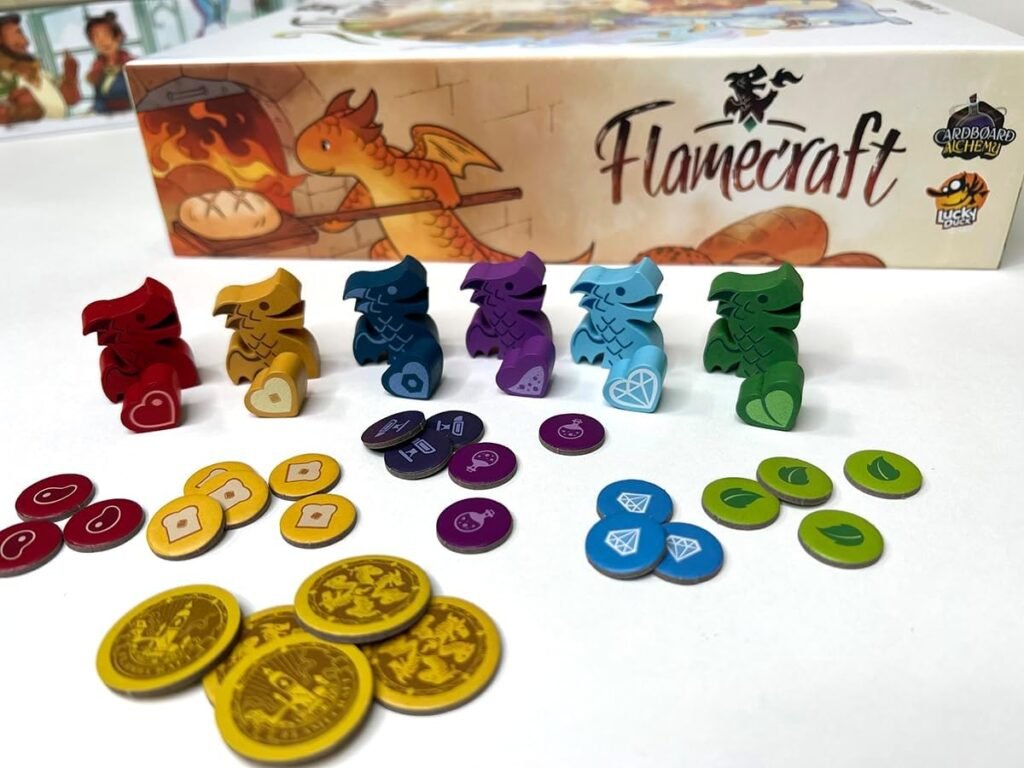
The Components
In “Flamecraft,” the visual appeal is striking, reminiscent of Studio Ghibli’s enchanting illustrations. Illustrator Sandara Tang brings a world filled with wonder, warmth, & joy to life, capturing the essence of dragons baking bread or creating potions amidst a vibrant village. This artistic excellence permeates every aspect of the game, turning “Flamecraft” into a literal work of art.
The neoprene mat that serves as the central game board is a standout feature, elevating the tactile experience with its quality & durability. It’s remarkable to see retail editions of board games include such high-end components. However, while the neoprene mat shines, the player pieces, though of good quality, don’t quite match the artistic style that defines “Flamecraft.” This minor contrast highlights the overall exceptional quality of the game’s components & visual flair.
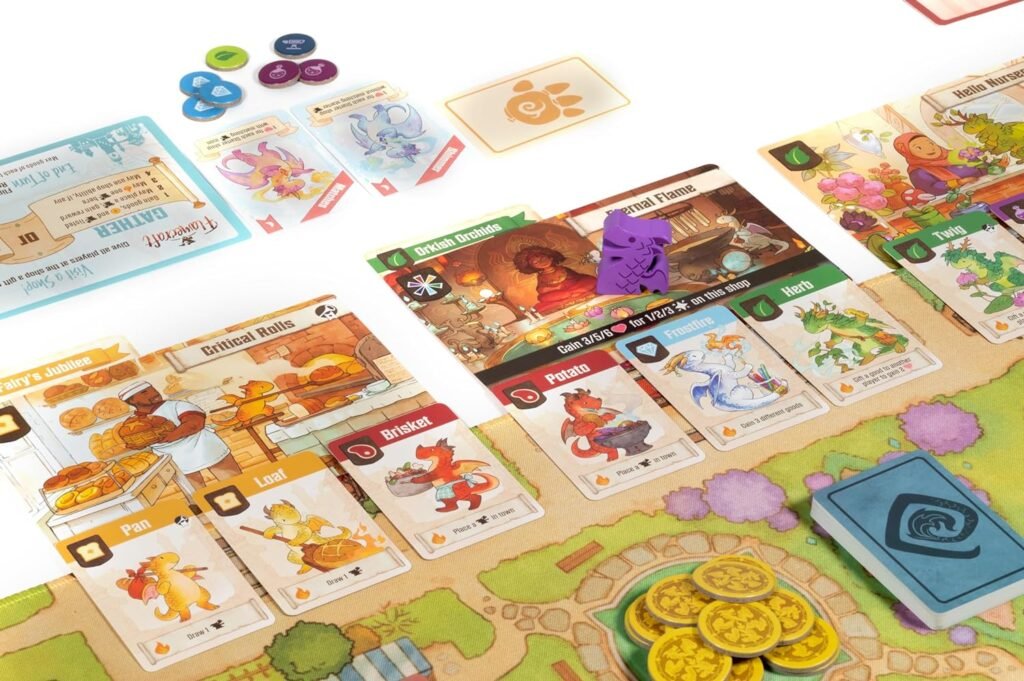
The Good
First & foremost, “Flamecraft” is incredibly accessible. The rules are straightforward, making it easy to teach & quick to learn. This accessibility makes it a fantastic choice for family game nights or casual gaming sessions with friends.
The theme & artwork are standout features. The cute & whimsical dragons bring a lot of personality to the game, & the enchanting artwork captures the magical essence of the world. This makes the game visually appealing & engaging for players of all ages.
The variety in dragon abilities & shop enchantments ensures that each game plays out differently. This replayability is enhanced by the strategic depth in deciding where to place dragons & how to utilize their abilities most effectively. The game strikes a great balance between luck & strategy, making it enjoyable for both casual & seasoned gamers.
The Bad
One potential downside is that the game may feel a bit light for players who prefer deeper strategic experiences. While there is strategy involved, it doesn’t reach the complexity of heavier Euro-style games. For those seeking a more intense gaming session, “Flamecraft” might come across as too simple.
Another point to consider is player interaction. While there is some interaction in terms of competition for shop spaces & dragon placements, the game is largely multiplayer solitaire. Players might find themselves more focused on their own board than on what their opponents are doing.
The Verdict
So, should you buy “Flamecraft”? If you’re looking for a charming, family-friendly game with a unique theme & beautiful components, the answer is a resounding yes. “Flamecraft” offers a delightful experience with enough strategic depth to keep things interesting without overwhelming new players.
For board game enthusiasts, “Flamecraft” is a solid addition to your collection, especially if you enjoy games with high replayability & engaging themes. It’s perfect for lighter gaming sessions & can serve as a great gateway game for introducing friends to the hobby.
However, if you’re in search of a deeply strategic, heavy game, “Flamecraft” might not fully satisfy that craving. Its light & breezy nature is part of its charm, but it also means that it doesn’t offer the depth of more complex games.

Final Thoughts
Flamecraft strikes a delicate balance between accessibility & depth, making it a standout in the realm of worker placement games. From the outset, its charming simplicity invites players in, offering a straightforward yet engaging experience that evolves gracefully with each play. The game mechanics, centered around community-building rather than cutthroat competition, foster a refreshing atmosphere of collaboration & strategic decision-making. This emphasis on generosity not only sets Flamecraft apart but also makes it a welcoming choice for those seeking a more cooperative gaming experience.
The game’s visual allure is undeniable, with artwork by Sandara Tang that captivates from the moment you lay eyes on it. This aesthetic excellence extends beyond mere decoration, enriching the thematic immersion & adding a layer of delight to every session. While setup may initially seem daunting due to its spatial requirements, the gameplay itself proves surprisingly streamlined & intuitive once underway. The dual action choices of gathering goods or enhancing shops offer a balanced dilemma, encouraging thoughtful planning without overwhelming complexity.
For solo play enthusiasts, Flamecraft delivers a satisfying experience, though it may feel slightly pared down compared to multiplayer sessions. Despite this, its blend of accessibility & strategic depth remains appealing, especially when seeking a relaxed yet engaging gaming session after a long day. The variability between plays, though somewhat limited, ensures that each session offers enough diversity to remain enjoyable over multiple plays.
While it may not cater to those seeking a deeply challenging or highly variable experience, Flamecraft shines as a family-friendly or casual gaming option. Its approximate playtime of 60 minutes places it squarely in the realm of a substantial filler game, ideal for game nights or gatherings where accessibility & visual appeal are paramount. Ultimately, Flamecraft’s combination of beautiful artwork, accessible gameplay, & thematic charm make it a worthy addition to any gaming collection, particularly for those who value aesthetic pleasure alongside engaging gameplay mechanics.
Purchase Options

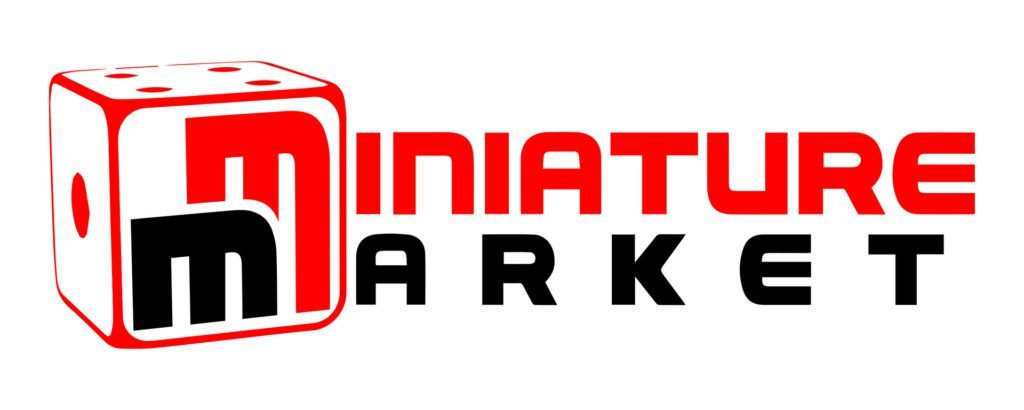

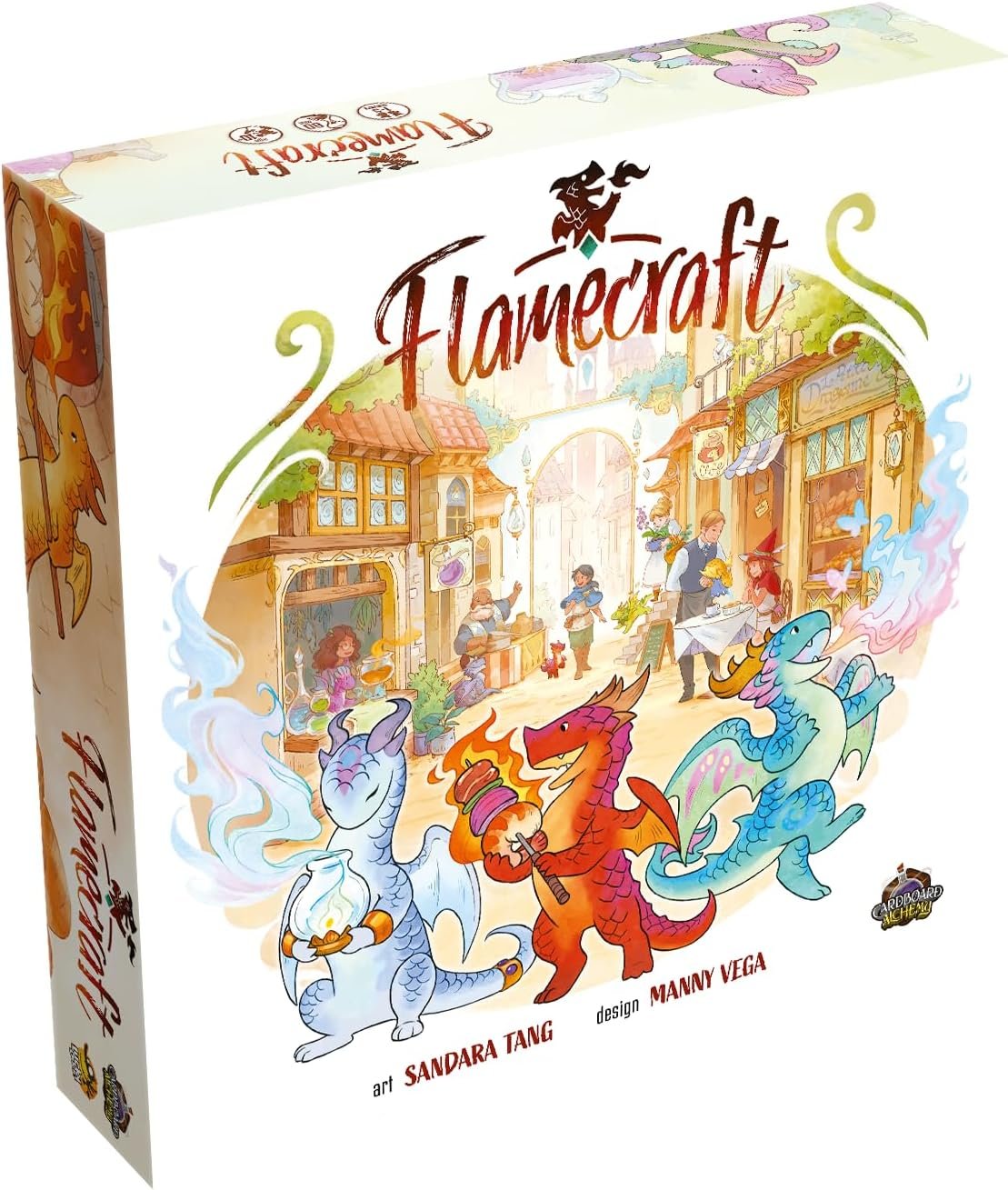
At no extra cost to you, The Board Game Site may receive revenue from affiliate and advertising partnerships for sharing this content and from purchases through links.



